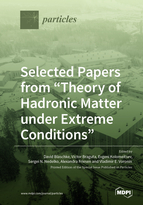Selected Papers from “Theory of Hadronic Matter under Extreme Conditions”
A special issue of Particles (ISSN 2571-712X).
Deadline for manuscript submissions: closed (30 April 2020) | Viewed by 26723
Special Issue Editors
2. Center for Advanced Systems Understanding (CASUS), D-02826 Görlitz, Germany
3. Helmholtz-Zentrum Dresden-Rossendorf (HZDR), D-1328 Dresden, Germany
Interests: quantum field theory; quantum statistics; quark gluon plasma; heavy ion collisions; compact stars
Special Issues, Collections and Topics in MDPI journals
2. Far Eastern Federal University, School of Biomedicine, 690950 Vladivostok, Russia
3. Bogoliubov Laboratory of Theoretical Physics, JINR, 141980 Dubna, Russia4. Moscow Institute of Physics and Technology, 141700 Dolgoprudny, Russia
2. Laboratory of Theoretical Physics, 1Joint Institute for Nuclear Research, RU-141980 Dubna, Russia
Interests: hadron structure; hadron resonances; particle production in heavy-ion collisions; in-medium effects; nuclear equation of state; neutron star physics
Special Issues, Collections and Topics in MDPI journals
Special Issues, Collections and Topics in MDPI journals
Special Issue Information
Dear colleagues,
We are happy to announce that Particles and the organizers of the conference "The II International Workshop on Theory of Hadronic Matter under Extreme Conditions" will collaborate to produce a Special Issue volume, for extended versions of selected papers from this conference (https://indico.jinr.ru/event/834/overview).
In its nature, theoretical investigations in the field of relativistic heavy-ion collisions have a multidisciplinary character involving physics at various energy scales. They ask not only for a resolution of the number of fundamental problems but also phenomenological studies directly connected with experiments. The progress in this field relies on a coherent implementation of a wide range of methods of quantum chromodynamics, relativistic nuclear physics, kinetic theory, hydrodynamics and physics of critical phenomena in finite short-lived systems. The construction of the Nuclotron-based Ion Collider fAcility (NICA), based on superconducting rings for performing experiments with heavy-ion beams in the collider as well as the fixed target mode sets up an auspicious environment for enhancement of theoretical physics activities at the Joint Institute for Nuclear Research (JINR) related to relativistic heavy ion physics.
As the Guest Editors, we would like to invite you to submit your unpublished and original research relevant to this topic for publication in this special volume of Particles. All submissions will be peer reviewed by internationally recognized experts. The Article Processing Charge (APC) for submissions from the conference will be free of charge.
Prof. Dr. David Blaschke
Dr. Victor Braguta
Prof. Evgeni Kolomeitsev
Dr. Sergei N. Nedelko
Dr. Alexandra Friesen
Dr. Vladimir E. Voronin
Guest Editors
Manuscript Submission Information
Manuscripts should be submitted online at www.mdpi.com by registering and logging in to this website. Once you are registered, click here to go to the submission form. Manuscripts can be submitted until the deadline. All submissions that pass pre-check are peer-reviewed. Accepted papers will be published continuously in the journal (as soon as accepted) and will be listed together on the special issue website. Research articles, review articles as well as short communications are invited. For planned papers, a title and short abstract (about 100 words) can be sent to the Editorial Office for announcement on this website.
Submitted manuscripts should not have been published previously, nor be under consideration for publication elsewhere (except conference proceedings papers). All manuscripts are thoroughly refereed through a single-blind peer-review process. A guide for authors and other relevant information for submission of manuscripts is available on the Instructions for Authors page. Particles is an international peer-reviewed open access quarterly journal published by MDPI.
Please visit the Instructions for Authors page before submitting a manuscript. The Article Processing Charge (APC) for publication in this open access journal is 1600 CHF (Swiss Francs). Submitted papers should be well formatted and use good English. Authors may use MDPI's English editing service prior to publication or during author revisions.
Keywords
- Confinement & chiral symmetry breaking in QCD
- Hadronic matter at nonzero temperature and baryon density
- QCD phase diagram
- Hydrodynamic and kinetic approaches to dense matter
- Approach to equilibrium
- Critical phenomena in finite statistical systems
- Strong electromagnetic fields in relativistic heavy ion collisions
- Lattice QCD
- Functional continuum methods
- Models of confinement and hadronization in QCD








